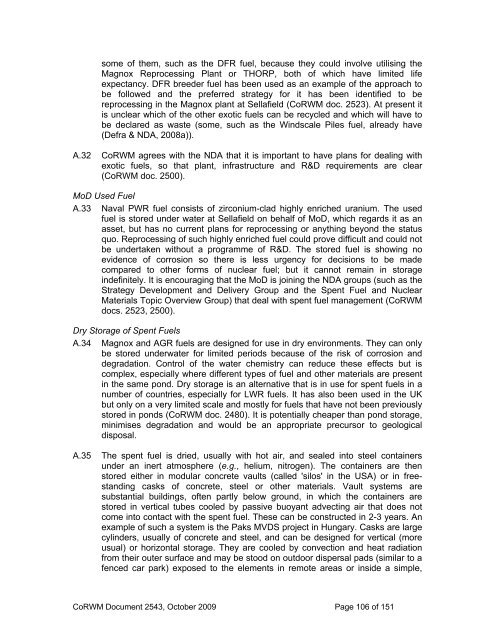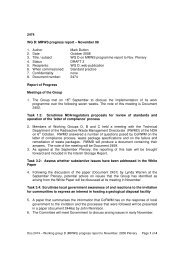2009 Report to Government on National Research and
2009 Report to Government on National Research and
2009 Report to Government on National Research and
- TAGS
- corwm.decc.gov.uk
Create successful ePaper yourself
Turn your PDF publications into a flip-book with our unique Google optimized e-Paper software.
some of them, such as the DFR fuel, because they could involve utilising the<br />
Magnox Reprocessing Plant or THORP, both of which have limited life<br />
expectancy. DFR breeder fuel has been used as an example of the approach <str<strong>on</strong>g>to</str<strong>on</strong>g><br />
be followed <strong>and</strong> the preferred strategy for it has been identified <str<strong>on</strong>g>to</str<strong>on</strong>g> be<br />
reprocessing in the Magnox plant at Sellafield (CoRWM doc. 2523). At present it<br />
is unclear which of the other exotic fuels can be recycled <strong>and</strong> which will have <str<strong>on</strong>g>to</str<strong>on</strong>g><br />
be declared as waste (some, such as the Windscale Piles fuel, already have<br />
(Defra & NDA, 2008a)).<br />
A.32 CoRWM agrees with the NDA that it is important <str<strong>on</strong>g>to</str<strong>on</strong>g> have plans for dealing with<br />
exotic fuels, so that plant, infrastructure <strong>and</strong> R&D requirements are clear<br />
(CoRWM doc. 2500).<br />
MoD Used Fuel<br />
A.33 Naval PWR fuel c<strong>on</strong>sists of zirc<strong>on</strong>ium-clad highly enriched uranium. The used<br />
fuel is s<str<strong>on</strong>g>to</str<strong>on</strong>g>red under water at Sellafield <strong>on</strong> behalf of MoD, which regards it as an<br />
asset, but has no current plans for reprocessing or anything bey<strong>on</strong>d the status<br />
quo. Reprocessing of such highly enriched fuel could prove difficult <strong>and</strong> could not<br />
be undertaken without a programme of R&D. The s<str<strong>on</strong>g>to</str<strong>on</strong>g>red fuel is showing no<br />
evidence of corrosi<strong>on</strong> so there is less urgency for decisi<strong>on</strong>s <str<strong>on</strong>g>to</str<strong>on</strong>g> be made<br />
compared <str<strong>on</strong>g>to</str<strong>on</strong>g> other forms of nuclear fuel; but it cannot remain in s<str<strong>on</strong>g>to</str<strong>on</strong>g>rage<br />
indefinitely. It is encouraging that the MoD is joining the NDA groups (such as the<br />
Strategy Development <strong>and</strong> Delivery Group <strong>and</strong> the Spent Fuel <strong>and</strong> Nuclear<br />
Materials Topic Overview Group) that deal with spent fuel management (CoRWM<br />
docs. 2523, 2500).<br />
Dry S<str<strong>on</strong>g>to</str<strong>on</strong>g>rage of Spent Fuels<br />
A.34 Magnox <strong>and</strong> AGR fuels are designed for use in dry envir<strong>on</strong>ments. They can <strong>on</strong>ly<br />
be s<str<strong>on</strong>g>to</str<strong>on</strong>g>red underwater for limited periods because of the risk of corrosi<strong>on</strong> <strong>and</strong><br />
degradati<strong>on</strong>. C<strong>on</strong>trol of the water chemistry can reduce these effects but is<br />
complex, especially where different types of fuel <strong>and</strong> other materials are present<br />
in the same p<strong>on</strong>d. Dry s<str<strong>on</strong>g>to</str<strong>on</strong>g>rage is an alternative that is in use for spent fuels in a<br />
number of countries, especially for LWR fuels. It has also been used in the UK<br />
but <strong>on</strong>ly <strong>on</strong> a very limited scale <strong>and</strong> mostly for fuels that have not been previously<br />
s<str<strong>on</strong>g>to</str<strong>on</strong>g>red in p<strong>on</strong>ds (CoRWM doc. 2480). It is potentially cheaper than p<strong>on</strong>d s<str<strong>on</strong>g>to</str<strong>on</strong>g>rage,<br />
minimises degradati<strong>on</strong> <strong>and</strong> would be an appropriate precursor <str<strong>on</strong>g>to</str<strong>on</strong>g> geological<br />
disposal.<br />
A.35 The spent fuel is dried, usually with hot air, <strong>and</strong> sealed in<str<strong>on</strong>g>to</str<strong>on</strong>g> steel c<strong>on</strong>tainers<br />
under an inert atmosphere (e.g., helium, nitrogen). The c<strong>on</strong>tainers are then<br />
s<str<strong>on</strong>g>to</str<strong>on</strong>g>red either in modular c<strong>on</strong>crete vaults (called 'silos' in the USA) or in freest<strong>and</strong>ing<br />
casks of c<strong>on</strong>crete, steel or other materials. Vault systems are<br />
substantial buildings, often partly below ground, in which the c<strong>on</strong>tainers are<br />
s<str<strong>on</strong>g>to</str<strong>on</strong>g>red in vertical tubes cooled by passive buoyant advecting air that does not<br />
come in<str<strong>on</strong>g>to</str<strong>on</strong>g> c<strong>on</strong>tact with the spent fuel. These can be c<strong>on</strong>structed in 2-3 years. An<br />
example of such a system is the Paks MVDS project in Hungary. Casks are large<br />
cylinders, usually of c<strong>on</strong>crete <strong>and</strong> steel, <strong>and</strong> can be designed for vertical (more<br />
usual) or horiz<strong>on</strong>tal s<str<strong>on</strong>g>to</str<strong>on</strong>g>rage. They are cooled by c<strong>on</strong>vecti<strong>on</strong> <strong>and</strong> heat radiati<strong>on</strong><br />
from their outer surface <strong>and</strong> may be s<str<strong>on</strong>g>to</str<strong>on</strong>g>od <strong>on</strong> outdoor dispersal pads (similar <str<strong>on</strong>g>to</str<strong>on</strong>g> a<br />
fenced car park) exposed <str<strong>on</strong>g>to</str<strong>on</strong>g> the elements in remote areas or inside a simple,<br />
CoRWM Document 2543, Oc<str<strong>on</strong>g>to</str<strong>on</strong>g>ber <str<strong>on</strong>g>2009</str<strong>on</strong>g> Page 106 of 151



